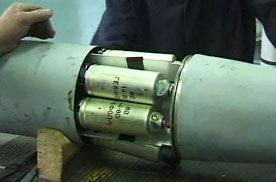NATO-sponsored project helps Ukraine destroy dangerous stocks of munitions
Stocks of unused and obsolete munitions pose a serious problem for many countries. Untended depots can be dangerous. In Ukraine, several unplanned explosions at munitions sites have led to loss of life, injury and significant damage. To protect people living near such depots, NATO is sponsoring a project to help safely dispose of the country’s excess munitions.

After the break up of the former Soviet Union, Ukraine inherited large quantities of weapons and ammunition. At the end of their service life, the surplus munitions become unusable. Often they are left outside, exposed to heat and humidity, which can cause them to become very unstable. Explosions at storage depots are always a risk. Sudden and often unexplained detonations pose a threat to people in the area.
To help make the area around depots safer for the local population, NATO is currently running a Trust Fund project in Ukraine to destroy the surplus munitions. “The primary purpose of the project is the destruction of stockpiles which are a threat to the population,” says Dr Frederic Peugeot, Trust Fund project manager with the NATO Maintenance and Supply Agency (NAMSA), which oversees work on the project.
Col. Oleh Levchenko, First Secretary of Defence and representative of the National Armament Director at Ukraine’s diplomatic mission to NATO, underscores the value of the initiative: “As the Trust Fund project provides not only the expertise and assets, but also allocates most of the funds needed for weapons destruction and ammunition demilitarization, its importance cannot be underestimated,” he says. “This project serves as a good example of constructive cooperation between Ukraine and NATO.”
Disposing of a deadly legacy

This project is a continuation of a previous five-year NATO Trust Fund project in Ukraine. During the first phase of the project, an explosive waste incinerator was built at the Donetsk State Chemical Plant and 400,000 small arms and light weapons, 15,000 tonnes of ammunition, 1,000 man-portable air-defense systems (MANPADS) and 500 grip stocks were destroyed.
The second phase of the project, launched in May 2012, is focusing on disposing of an additional 366,000 small arms and light weapons, demilitarizing 76,000 tonnes of conventional ammunition including three million PFM-1 anti-personnel landmines.
The United States is the lead nation for the 25 million Euro project. “There is a basic need in Ukraine for this type of work and NATO is fulfilling that requirement,” says Rigo Garza, Political Officer with the United States Mission to NATO.
Building on the experience contractors gained in the first phase of the project means faster implementation this time around. The project is expected to be completed within four years.
